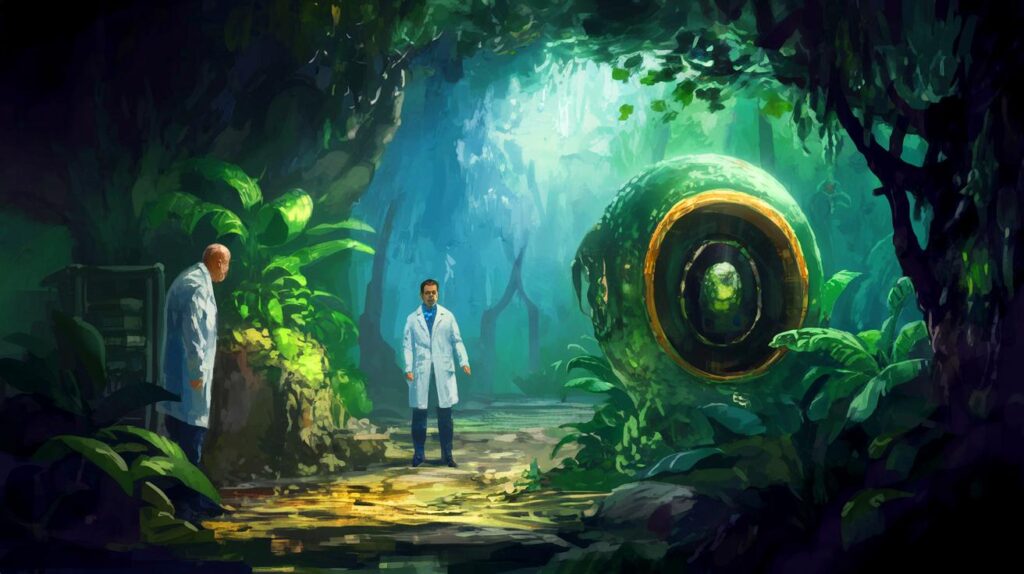| IN BRIEF |
|
The warm blue waters of the Solomon Islands, located in the South Pacific, harbor a natural wonder of impressive size. It is neither a whale nor a giant squid, but a massive coral colony recently discovered by a team of researchers and filmmakers. This coral, measuring 34 meters in width and 32 meters in length, is visible from space. This discovery sheds light on the still unexplored richness of our oceans and raises questions about the preservation and future study of marine ecosystems.
An Exceptional Phenomenon
The finding of this enormous coral in the Solomon Islands is a remarkable event for the scientific community. Composed of millions of polyps, this colony is unique due to its size and structure. Corals like Pavona clavus grow very slowly, indicating that this individual is probably centuries old. Discovered by Manu San Félix during a National Geographic expedition, this coral amazes with its grandeur and color, ranging from yellow to green and purple. This discovery comes at a crucial time for coral reefs, which face numerous threats.
Coral reefs play a vital role in the marine ecosystem, providing refuge for many species. However, with climate change, these ecosystems are in danger. Excessive ocean heat causes coral bleaching, threatening their survival. Discovering a coral of this size that has survived several bleaching episodes offers a glimmer of hope for the resilience of coral reefs in the face of environmental changes.
Impact of Climate Change
Coral reefs around the world are facing unprecedented bleaching crises, primarily due to climate change. In 2023, three-quarters of coral reefs have already experienced ocean temperatures high enough to cause bleaching. The coral discovered in the Solomon Islands could be a notable exception, having survived multiple bleaching episodes due to its depth and potentially protective genetic factors. This resilience might provide insights into the preservation of other reefs.
Coral reefs are not only natural wonders but are also crucial for coastal protection against storms, providing habitat for commercial fish, and supporting tourism. The gradual disappearance of these reefs jeopardizes the livelihoods of millions who depend on these marine ecosystems. The urgency to protect these corals is even greater. The discovery of this giant coral could catalyze increased conservation efforts and raise awareness about the importance of protecting our oceans.
A Symbol for Marine Conservation
The discovery of this coral in the Solomon Islands could play a crucial role in marine conservation. Indeed, this giant coral could become a powerful symbol to encourage the creation of new protected marine areas. According to Dennis Marita, from the Po’onapaina tribe and director of culture at the Ministry of Culture and Tourism of the Solomon Islands, this discovery could bring the necessary recognition to establish an official marine protected area around Malaulalo. Although the tribe has already undertaken conservation efforts, government support could strengthen these initiatives.
The protection and management of these marine spaces are essential for ensuring the survival of numerous marine species. Coral reefs, in particular, need to be preserved not only for their beauty but also for their crucial role in maintaining marine biodiversity. The giant coral discovered could be a catalyst for change, raising awareness of the importance of protecting marine ecosystems for future generations.
A Hope for the Future
As coral reefs around the world face increasing pressures, the discovery of this massive colony in the Solomon Islands offers renewed hope. While the impressive size of this coral alone is not a solution to environmental threats, it can inspire and mobilize collective efforts for conservation. As Maria Beger emphasizes, it is crucial to maintain a diversity of corals of all shapes and sizes to ensure the resilience of reefs.
This discovery raises important questions for the future of marine conservation. How can we use this finding to strengthen efforts to preserve coral reefs? What other secrets do the ocean depths hold that could transform our understanding of marine ecosystems and their protection?







